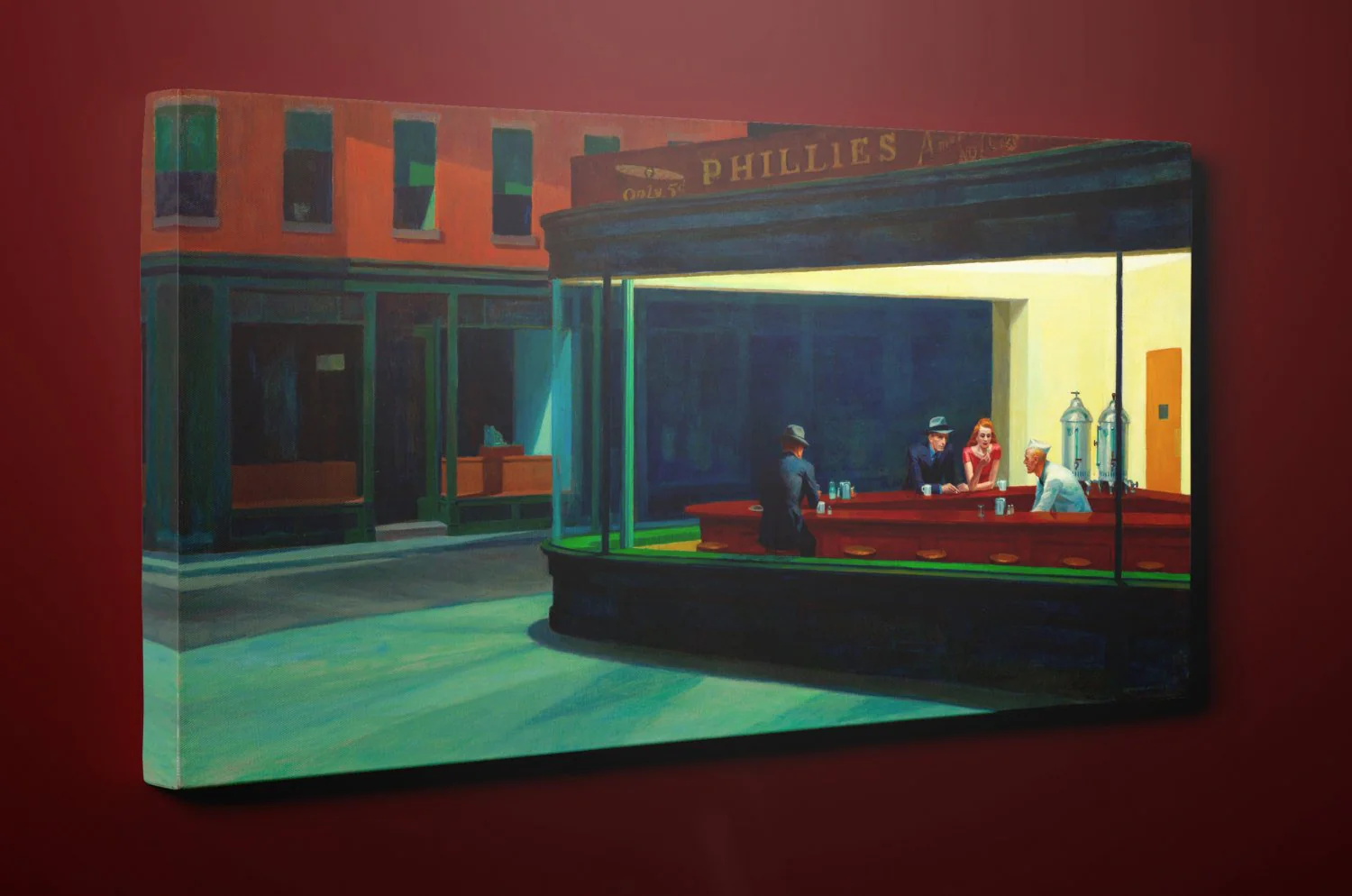Edward Hopper: Who Was He?
American realist painter Edward Hopper Nighthawks frequently captured the serene and frequently depressing aspects of contemporary life in his paintings. Hopper was born in Nyack, New York, in 1882, and his art speaks for itself via its quiet. His attention was always drawn to the peaceful, lingering moments in between the uproar, never to turmoil or excess.
Themes and Style of Hopper’s Art
Although not in the conventional sense, Hopper was a master of reality. His paintings frequently used light, composition, and expressionless characters to evoke a range of emotions. Introspection, urban alienation, and loneliness are common themes. With uncanny accuracy, his brush encapsulated the essence of American life in the 20th century.
The Origin of Edward Hopper Nighthawks
The painting’s year and medium
“Nighthawks” is an oil painting that was completed in 1942. It is perhaps Hopper’s most well-known piece and is 33.1 by 60 inches.
What Gave Nighthawks Their Start?
According to legend, Hopper was influenced by a Greenwich Village diner, albeit he never verified the exact whereabouts. The female figure in the artwork was even posed for by his wife, Josephine. A simple late-night doodle served as the inspiration for the visual symphony of loneliness.
The Creative Process of Hopper
Hopper was very careful. He drew a number of preliminary drawings, modifying each character’s position and angle. He was more concerned with creating a feeling of alienation in the midst of contemporary metropolitan life than he was with realism.
An Examination of Nighthawks Visually
An explanation of the scene in the diner
The image shows four people at a modern, well-lit diner late at night. The diner is situated on a corner, creating a gap between deserted, gloomy streets. The diner has a huge glass window that frames the interior like a stage, but no obvious entrance.
Utilizing Shadow and Light
The lighting in the painting is what makes it so brilliant. The diner’s neon lighting stands in stark contrast to the dark streets outside. The emotional distance between the people and the surrounding city is highlighted by this sharp difference.
Personas and Their Feelings
The Man Who Is Alone
A man in a black suit slouches with a cup of coffee at the far end of the counter. You can feel how alone he is. The quiet around him is nearly audible.
The Pair
Sitting together, but not actually together, are a man and a woman with red hair. They are not conversing. Even in close proximity, their body language conveys a sense of detachment.
The Attendant
The attendant behind the desk seems to be in the middle of a discussion, or perhaps just replying politely. Caught in a cycle of duty and detachment, he is the only one remaining.
Nighthawks: An Examination of Themes in Urban Isolation
None of the figures appear to be connected, even if they are in the same area. Hopper does a fantastic job of showing how incredibly lonely a busy city can be.
Modern-Day Loneliness
After the war, the artwork came to represent isolation and disconnection. Despite being in the same room, the eaters are divided by imperceptible emotional barriers.
Quietness in a City Without Sleep
The painting doesn’t move at all. The silence is uncanny. Time seems to have stopped, permanently preserving a brief, everyday moment.
The Significance of Nighthawks
The Barrier of Glass Windows
The enormous pane of glass serves as both a literal and symbolic wall. Like the people within, the viewer is an outsider looking in, and they are both isolated.
The Function of Light
The artificiality of human interaction is highlighted by the strong light in the diner. It highlights the characters’ loneliness and calls attention to them.
Architecture as a Separator
The black city encloses the diner, enclosing it. Its angular lines highlight emotional compartmentalization and detachment.
Critical and Public Reaction
In 1942, How It Was Received
“Edward Hopper Nighthawks” was met with muted praise when it was first released. It was acquired by the Art Institute of Chicago for $3,000, which at the time was a substantial amount.
Its Persistent Effect on Art
The painting’s significance has only increased since then. It is referenced in movies, imitated in pop art, and studied in classrooms. It is a cultural remnant rather than just an artwork.
Nighthawks, where are you today?
The Chicago Art Institute
From 1942 till the present, “Edward Hopper Nighthawks” has been on display at The Art Institute of Chicago. It is still one of their most valuable items.
Reproduction and the Impact of Culture
“Nighthawks” has been copied repeatedly into puzzles and posters. In popular culture, it has become a shorthand for loneliness.
Nighthawks in Popular Culture
Homages and Parodies
Numerous adaptations of “Edward Hopper Nighthawks” have been made, ranging from “The Simpsons” to “Blade Runner.” Its format is so recognizable that it can be interpreted in countless ways.
References to Literature and Film
Hopper’s eerie evening cafe served as an influence for writers like Joyce Carol Oates and filmmakers like Ridley Scott. It generates an atmosphere that is ideal for storytelling.

My Own Thoughts on Why Edward Hopper Nighthawks Still Have An Impact Today
The emotional impact of “Edward Hopper Nighthawks” is uncannily relevant in a post-pandemic world of Zoom calls and social distancing. It conveys a timeless and global quality.
What the Painting Can Teach Us
Sometimes the truth can be found in silence. We learn from “Edward Hopper Nighthawks” that it’s acceptable to be completely alone, even in a throng. It serves as a mirror of our contemporary emotional environments.
In conclusion
More than just a painting, Edward Hopper Nighthawks is a psychological landscape, a silent whisper of a city, and a monument to human isolation. It has addressed the conflict between connection and solitude for decades with its captivating light, mute people, and cinematic composition. The feelings it evokes are genuine, profound, and unforgettable, regardless of whether you’re an art enthusiast or you’re just strolling past a duplicate on a café wall.

